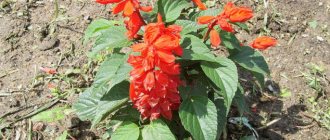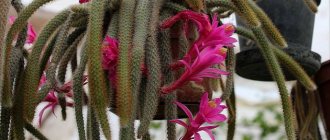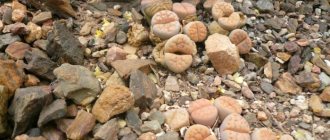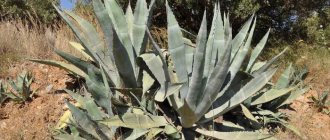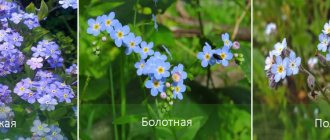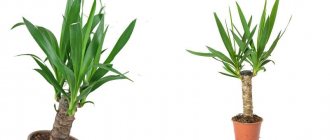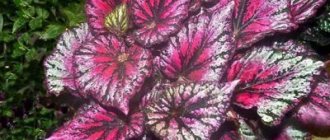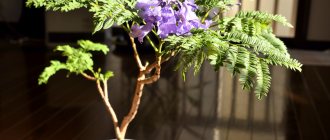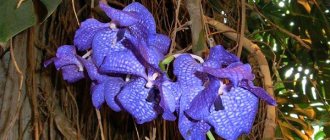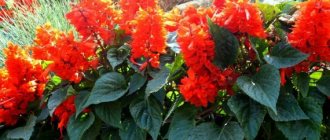Bee sage
Pigeon sage (S. columbariae)
An annual plant from the southwestern regions of North America. Like Spanish sage (S. hispanica), widely cultivated by the Aztecs as a staple food before the Spanish colonized the Americas, this plant produces tiny seeds very rich in omega-3 fatty acids, antioxidants, vitamins, minerals and fiber.
Sage pigeon
Diviner's sage (S. divinorum)
The variety exists only in culture and was used for many centuries by Mexican Mazatec shamans as a means of inducing prophetic visions and promoting spiritual cleansing. Despite the hype surrounding it, this plant has nothing in common with either LSD or cocaine.
Related article:
Varieties and varieties of rose hips
Sage Diviners
According to doctors, it does not cause pathological dependence and does not have toxic properties. But in Australia, South Korea, Belgium, Italy and Denmark, this “weed” is prohibited.
Species with fragrant foliage. Some of these plants are used in cooking. Pineapple sage, which has narrow clusters of red flowers and pineapple-scented leaves, is often used to flavor drinks and as a seasoning for desserts.
One variety of this sage (Honey Melon) smells like cantaloupe, while Doris sage (S. dorisiana), with its large, lush clusters of pink flowers and wide leaves, smells of peach and other fruits. Cleveland sage (S. clevelandii), which grows in California, also has very fragrant leaves.
Apple sage (S. pomifera) is found on several Greek islands. Local residents candy the translucent galls that form on its leaves and eat them as a sweet.
Description of flowering plants of the genus Sage
Salvia belongs to the Lamiaceae family. In addition to its culinary properties, this plant is used in garden decoration and its medicinal properties are also well known. There are nearly 1,000 species and cultivars of shrubs, herbaceous perennials and annual herbs in the Salvia genus worldwide, including the two well-known plants Salvia officinalis (Common sage) and Salvia rosmarinus or Rosemary (formerly Rosmarinus officinalis). Salvia is distributed on all continents.
The common modern name Salvia comes from the English sawge, which was borrowed from Old French sauge and Latin salvia. In everyday life, Sage is usually called the culinary plant Salvia officinalis (“Common Sage”). Ornamental species are usually referred to by the generic name Salvia. All Salvia species include perennials, annuals, semi-woody subshrubs, tall plants and groundcovers.
As a rule, most Salvia species have strong stems, the average height of which is about 1.5 meters. The leaves are usually entire, but sometimes serrated or pinnately divided. Flowering stems produce small bracts, unlike basal leaves - in some species the bracts are quite showy.
Flowers are formed in racemes or panicles; their coloring can vary depending on the species or variety: from blue to red, sometimes white and yellow. Salvias bloom from late spring to fall, with some blooming a little earlier and others blooming later.
The fruits are smooth, can be ovoid or oblong nuts, and in many species they are covered with a shell.
Red sage (Salvia coccinea)
Sage Lady in Red
An herbaceous perennial or subshrub from Brazil, in temperate regions it is grown as an annual, and in the mild climate of Western Europe it can overwinter under light cover and blooms until early winter. Bush 30-60 cm high with oval, pubescent leaves below. Flowers with a purple calyx and a scarlet two-lipped corolla are collected in loose inflorescences.
This species is inferior in the splendor of flowering to the brilliant sage, so it is rare here, but is popular abroad, used in mixborders and flower beds in a rural style. Popular varieties: Lady in Red - with red and Coral Nymph - with coral-pink flowers.
Planting and caring for Sage in the garden
Salvia can be planted in a garden bed or in a flower garden; it is often grown at home by planting it in pots. Let us dwell in more detail on the requirements of this herbaceous flower when grown in open ground.
Where is the best place to plant Salvia or Sage?
An ideal place to plant a plant in the garden is where onions, cabbage, potatoes or legumes previously grew.
You also need to take into account the lighting requirements of Sage:
- all Salvias grow in full sun;
- many ornamental varieties (usually with light flowers) also do well in partial shade, but their flowering will be weaker;
- The ideal location for the landing site would be on the south side;
- Salvias look great when planted in groups of three or more.
Suggested places for planting ornamental varieties are flower borders and flower beds, patios.
When is the best time to plant Salvia?
The most optimal period for planting flower seedlings will be early spring, after the end of frost. Seeds can be sprouted indoors by sowing them in a container 6-8 weeks before the last frost, and planting the seedlings after the threat of freezing temperatures has passed.
You can also sow Salvia seeds directly into open ground in May or August.
You can also sow Sage seeds directly into the soil in the fall (the later the better) so that they cannot germinate before the onset of frost. This way they will overwinter well, and in early spring they will begin to sprout new shoots.
Soil requirements
Where you plant your Salvia seedlings will depend on the species and variety. Sage loves well-drained soil most of all. Garden soil of average fertility is suitable for most plant varieties.
When planting in pots, use a mixture of regular garden soil and perlite. This allows the water to drain quickly.
You might be interested
Ornamental grass Fine feather grass
Review of the best ornamental grasses for garden decoration
Japanese grass Hakonechloa large
How to plant Salvia flower seedlings in open ground
First you need to prepare a place for planting:
- Loosen the soil to a depth of 30 cm, removing any large stones or weed roots.
- Mix the soil with humus or potassium-phosphorus fertilizers to provide it with nutrients.
Further actions will not be difficult:
- dig a hole twice the diameter of the pot in which the plant is located;
- remove the seedling from the container and place it in the hole so that the upper part of the root ball is flush with the soil surface;
- the distance between plants is from 30 to 90 cm, depending on the variety;
- fill the voids around the roots of the plant with soil and compact them carefully;
- Water the planting site thoroughly and mulch.
Remember - the Salvia flower is capable of cross-pollination, so different varieties need to be planted far from each other.
You can learn more about planting Salvia seeds for seedlings and planting seedlings in open ground from this video.
Whorled sage (Salvia verticillata)
Sage whorled Purple Rain
A perennial species widespread in nature from Europe to Western Siberia. A plant 30-80 cm high with simple stems, heart-shaped leaves and blue-violet flowers collected in dense whorled inflorescences.
There are varieties such as Purple Rain with purple stems and reddish-purple flowers, White Rain with white flowers, Hannays Blue with purple sepals and bright blue petals, and others.
Exotic species of sage are rarely found in our gardens and even in the collections of advanced hobbyists, but they can also find their place in flower beds.
Further care for Sage (Salvia) in the garden
Salvia does not require regular care. It does not need special conditions for growth; the most important thing is to weed in time to remove weeds and loosen the soil. It is also worth knowing about other necessary procedures that you should pay attention to.
Watering
It is necessary to moisten the soil in the hot summer if the amount of precipitation is less than 3 cm per week. Salvia does not like excessive watering.
Some types of Salvia are more demanding of moisture.
Top dressing
If during planting you have sufficiently enriched the soil with organic matter, you should not apply fertilizers in the future. The flower will feel the seed perfectly without additional feeding.
Trimming
Remove dead stems from perennial plants. In some species of Salvia, the lower stems become woody with age. Feel free to trim them, leaving about ten centimeters above the ground. Also, after the first frost, cut the stems 5-7 cm above the soil level.
Pruning is also important to encourage re-blooming. However, if you want to collect the seeds, leave a few buds to dry naturally on the plant. Collect the seed pods and shake them into a bag or jar.
Pruning after flowering helps maintain a better, bushier shape and stimulates the Salvia.
Harvesting Sage
The leaves and flowers of Common Salvia can be collected for culinary purposes at any time. Preference is given to young leaves that have a brighter taste. Excess leaves and flowers collected can be dried or frozen. Freezing is the best option for preserving foliage collected in midsummer.
The first year after planting Salvia, harvest by only lightly trimming a few leaves at a time. After the first growing season, harvest the plants freely. You can cut individual leaves or 15 to 20 cm of green stem with leaves. It is better to collect leaves before flowering.
Meadow sage (Salvia pratensis)
A perennial European species 30-60 cm high with elongated, wrinkled, heart-shaped leaves and large violet-blue flowers collected in rare inflorescences up to 45 cm long. The species is considered a juvenile, that is, the plants need to be renewed every 2-3 years.
European varieties (Pink Delight with pink flowers, Indigo with dark blue flowers on a dark peduncle, Swan Lake with white flowers and others) are usually less winter-hardy than the main species, which can withstand frosts down to –28°C.
Sage propagation
A gardener can take cuttings of the perennial Salvia flower in spring or early fall.
Some species often reproduce themselves, so you may find young seedlings in your flowerbed that can be used in other parts of your garden.
How to cut Salvia?
- Before the flower buds appear, take stem cuttings from vegetative (non-flowering) branches about 10cm long. Remove the lower leaves and cut each cutting just below a node.
- Place them in a pot with pre-moistened soil. Cover the pot with a clear plastic bag - try not to let the bag touch the foliage.
- Place the container in a cool greenhouse and shade it to prevent burns from strong sunlight.
- After three weeks, the cuttings will be ready to be transplanted to a new location.
Salvia officinalis
Salvia officinalis Purpurascens.
A subshrub from the Mediterranean and Asia Minor, up to 50 cm high, with oblong, wrinkled, pubescent, bluish-green leaves and purple flowers. In the middle zone it is often grown as an annual and its medicinal leaves are harvested. In southern regions and in a protected place with shelter in gardens of the temperate zone, it can overwinter.
Interesting decorative variegated varieties are Purpurascens with purple-violet leaves, Tricolor has a cream border and purple strokes, Aurea with a yellowish border of leaves and others.
Diseases and pests of Salvia flower
Despite the fact that Sage has insecticidal properties and is considered a spicy medicinal plant, due to frequent watering it can be damaged by mold. In this case, the affected areas must be treated with a liquid sulfur mixture.
Pests and diseases are rarely a problem for Salvia. The most common problems in caring for Salvia flowers can arise from aphids, spider mites, and whiteflies. You can get rid of pests using folk remedies or insecticides.
You may also encounter diseases such as Powdery Mildew, Root Rot and Botrytis.
Small-leaved sage (Salvia microphylla)
Salvia parvifolia Hot Lips
Mexican evergreen subshrub 60-100 cm high with oval green leaves and bright red flowers collected in brushes at the tops of the shoots. This species is sometimes called blackcurrant sage, due to the unusual aroma of the leaves, which is reminiscent of blackcurrant or mint.
It is a heat-loving plant, the minimum permissible temperature for it is -5°C, so it can be grown in open ground only in the southern regions, and in the middle zone it can be kept in containers, sent for wintering in a bright, frost-free room.
It blooms already in the first year, but the bush reaches full development in the second year of life. Popular varieties include Red Velvet with rich red flowers, Pink Beauty with pink flowers, Hot Lips with bicolor, red and white flowers.
Application of Salvia in landscape design
Despite its fame as a culinary plant, landscape designers often use Salvia in the garden. You can create unusual flower arrangements from different types and varieties. The most commonly used variety is the nutmeg variety. However, to improve the spice bed, tandems with Mint or Basil, Rosemary or Thyme, Oregano and Hyssop are mainly used.
How else can you use Sage in garden decoration?
- The variety of colors, sizes and long flowering periods make Salvia an ideal addition as a border plant.
- Sage pairs well with plants with brighter foliage and larger flowers.
- Some species bloom late and beautifully brighten the autumn palette, extending the flower season.
- In large flower pots, low-growing Salvias serve as fillers of empty spaces or drape the edge of the pot; taller species can be the centerpiece of the composition.
- Salvias attract butterflies and other pollinators and make great additions to nature-style gardens.
Medicinal properties of Sage
Salvia vulgare (or Salvia officinalis) is the source of many healing properties. It has a soothing, antibacterial, anti-inflammatory and antimicrobial effect. Sage is used as a natural cleanser and pesticide.
- This aromatic herb contains caffeic acid, chlorogenic acid, rosmarinic acid, ellagic acid, and rutin, all of which play important roles in its health benefits.
- Sage contains more than 160 different polyphenols, plant-derived chemical compounds that act as antioxidants in the body.
- One study found that drinking 1 cup (240 ml) of Sage tea twice daily significantly increased antioxidant protection. Salvia drink also reduces the amount of “bad” cholesterol and also increases the level of “good” cholesterol.
- Sage has antimicrobial properties that can neutralize germs that contribute to plaque formation.
- Salvia may help reduce the intensity and frequency of menopausal symptoms such as
- hot flashes and irritability.
- Fresh Salvia leaves are a traditional remedy for diarrhea. Research has shown that
- The plant contains compounds that can relieve diarrhea by relaxing the intestines.
- Salvia leaf extract has been shown in humans to lower blood sugar and improve insulin sensitivity.
- Several animal and test-tube studies have shown that Salvia may fight certain types of cancer, including oral, colon, liver, cervical, breast, skin and kidney cancers. So far, these studies have not been conducted in humans.
Contraindications
Contraindications to the use of sage-based products:
- low thyroid function;
- acute renal failure;
- inflammatory processes in internal organs;
- high estrogen levels;
- hypertension;
- endometriosis;
- oncological diseases;
- individual intolerance;
- During pregnancy and breastfeeding.
Prolonged and uncontrolled use of sage-based products provokes symptoms of poisoning. Side effects of sage include dizziness, nausea, and increased body temperature. If these symptoms are detected, you should stop taking the medications and consult a doctor.
With regular use of herbal preparations, an allergic reaction may develop. Therefore, before you start using the products, you must consult with a specialist and strictly follow the instructions for using sage.
Varieties of Sage or Salvia
We list the most common types of plants.
Salvia officinalis
The most famous culinary plant from the genus Salvia. This perennial plant with woody stems reaches a height of about 50-70 centimeters. It is often grown in gardens with other herbs as an ornamental plant in flowerbeds or rock gardens.
Photo of Salvia officinalis
The greyish-green leaves, the surface of which is covered with fluff, are thin and elongated in shape. The flowers are blue and bloom in the form of spikes. It is used in medicine and cooking, and is also used in cosmetology.
Clary sage (Salvia sclarea)
Perennial or annual crop. Despite the fact that the plant is medium-sized, sometimes there are meter-sized specimens.
Clary sage (Salvia sclarea)
It is distinguished by lush buds of a dark purple color.
Meadow sage (Salvia pratensis)
Woody perennial plant with wrinkled oval leaves up to 20 cm in length and erect stems with long violet-blue, rarely pink or white spines, flowers 2-3 cm long, in early and mid-summer. It reaches a height of 80 centimeters.
Grows in light, moderately fertile, humus-rich, moist but well-drained soil. Does best in full sun, but can tolerate light partial shade.
Salvia splendens
Another name for the species is Salvia brilliantis. A compact evergreen perennial up to 45 cm tall and up to 30 cm wide. Numerous cultivars are available in garden centers, ranging in color from the traditional red to purple and white.
This Salvia blooms continuously from spring to autumn. The flowers are formed on spikes and are two-lipped. The leaves are light to dark green, elliptical, serrated. The foliage is fragrant when crushed.
Oak sage (Salvia nemorosa)
Also known as purple sage, it is a perennial plant that blooms in various shades of purple and lavender from June to September.
Oak sage (Salvia nemorosa)
These vigorous herbs have spear-shaped leaves and many purple-blue spines. Many gardeners trim fallen flowers (or trim them with pruning shears), but sometimes they bloom all summer long even without pruning. Removing fallen flowers will keep the plant looking tidy. The flowers are purple with a blue tint, shaped like a spike, and reach a height of 70 centimeters.
Blue sage (Salvia azurea)
It has pale blue inflorescences and many small flowers.
Blue sage (Salvia azurea)
Flowering starts in July and lasts until October. Enjoys the greatest success among gardeners.
Salvia divinorum
Another name for this flower is Sage of fortunetellers or narcotic. This species is known for producing the psychoactive hallucinogen salvinorin A from its leaves.
In nature, Salvia divinorum is found in a small area in the mountains of Central America. In most European countries, breeding and growing this plant is prohibited by law.
The article uses materials from the resources: almanac.com and healthline.com
Mealy sage (Salvia farinacea)
An erect perennial plant native to Central America with a height of 45 to 90 cm. This species is distinguished by shiny, dark green, narrow leaves and whitish sepals covered with dense pubescence. Dark blue flowers are collected in whorls. The heat-loving plant can withstand temperatures down to –7-12°C in winter; in the temperate zone it is grown only as an annual; it is suitable for container culture; it can be cut; the inflorescences can be used for dry bouquets.
Popular varieties: Victoria Blue - with violet-blue flowers and dark sepals, Reference with powdery white cups and purple petals, Fairy Queen - with sapphire blue flowers decorated with small white spots, Evolution - with dark purple flowers.
